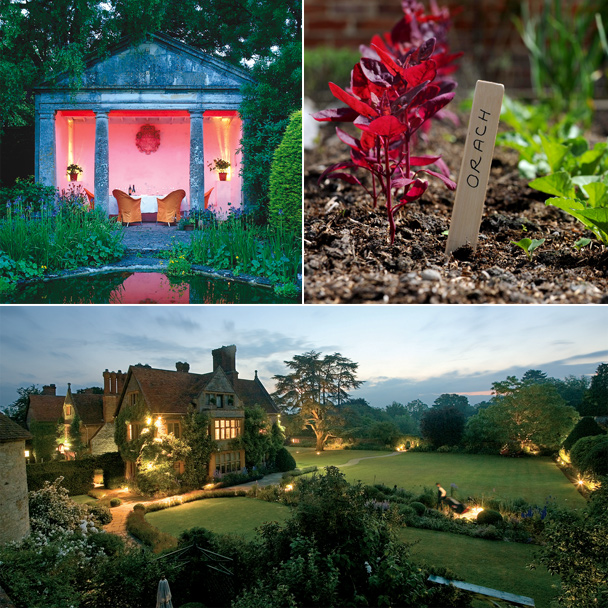When Shakespeare wrote his love-struck valentine to England, calling the island “This other Eden, demi-paradise/This fortress built by Nature for herself,” he couldn’t well have predicted that Nature might eventually cede the fortress to developers. But in spring, wide swaths of England still resemble Shakespeare’s blooming arcadia, especially when the typically contrary sun stays fixed in the sky and all the British gardens seem to suddenly blossom at once sometime in April.
Until recently those gardens were mostly great photo ops. But as we enter the third decade of the storied English gastronomic revolution, the best of the country’s rural chefs have kicked off a garden-to-table trend. At England’s new wave of culinary country inns—an exploding species of boutique digs that let you sleep off that dinner in a grade A historic landmark—the garden isn’t just scenery, it’s also a preview of dinner. Planting herb gardens, fruit orchards, and kitchen gardens in growing numbers, England’s chefs are looking to the great English garden as a prime source of ingredients and inspiration, and forcing those fertile patches to do double-duty like never before. The traditional culinary tour of the shires, with its dowdy tea rooms serving dead-weight scones and drab diners slinging shepherd’s pies the sheep wouldn’t eat, has evolved into a supremely fresh taste of the English countryside.
Start your garden drive at Sissinghurst Castle in Kent. Long considered the model of the classic English garden, Sissinghurst’s were planted in the 1930s by the writer Vita Sackville-West (known for her novels, her garden writing, and her love affair with Virginia Woolf) and her diplomat husband Harold Nicolson. Snubbing the stiff formality of the French garden, the couple planned an homage to the raw beauty of a wild English spring, with azalea banks, rose gardens, and arched hedgerows. The result, though carefully designed, feels like it sprouted organically.
Until recently, you could only visit the Sissinghurst garden during the day alongside the bus tour crowds. But as of this spring, the National Trust rents out the Priest’s House for long weekends or midweek stays, so you can have the whole blooming place to yourself once the crowds leave. The brick Elizabethan banqueting house is all wood beams and fireplaces, and the leaded windows frame an ethereal view of the White Garden, its beds of irises, ferns, white tulips, and hostas glowing in the dusk.
At the manor’s Granary Restaurant, which sits just outside the garden walls, Sackville-West’s grandson Adam Nicolson and his wife Sarah Raven have been working for the past five years to update the menu from grim self-serve cafeteria to locavore landmark, serving a pristine echo of the gardens. The restaurant uses estate ingredients as well as produce from an organic vegetable plot in its revival of venerable Kentish recipes, and serves a more-than-ample supply of local wines, ciders, and juices. A salmon pâté is accompanied by a Sissinghurst salad prepared with the vegetable plot’s own peppery mizuna, and a free fall of Kentish carrots, beetroot, broad beans, watercress, organic eggs, and berries rouse diners’ palates. Best of all are the classic British puddings with nursery-room names, such as the whim-wham: sponge cake, cream, caramelized almonds, and orange rind.
Heading north from Kent to the Cotswolds, you’ll find another classic English garden framing its own boutique hotel and restaurant, the Barnsley House. The life’s work of dogged, mud-spattered gardening doyenne Rosemary Verey, Barnsley was designed in the 1950s to suit her vision of the supreme English garden, and the blooming 11-acre epic is a variegated sweep of formal lawns, meadows, knot garden, a laburnum walk, and fruit, vegetable, and kitchen gardens.
Everything at Barnsley House bows to Verey’s gardens. While the hotel’s 18 guest rooms, renovated in 2011, veer toward the contemporary (Verey wouldn’t know what to make of the plasma TVs in the bathrooms), the Cotswolds-goes-Chelsea vibe is mitigated by rustic four-poster beds, stone fireplaces, and generous views of the grounds, with the prevailing whiff of flowers meeting you at every turn. The flavor of the gardens is evoked most fully at the hotel’s Potager Restaurant. The banquettes in the recently refreshed dining room face the hotel’s main lawn, where you may see head chef Graham Grafton (a veteran of London’s acclaimed Caprice and Bibendum) tromping off to pluck dinner from the vegetable plot.



 Pinterest
Pinterest


